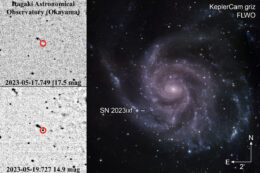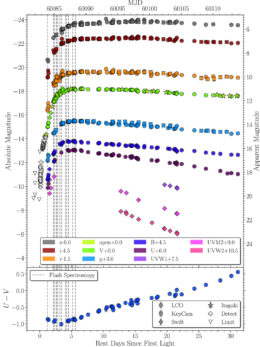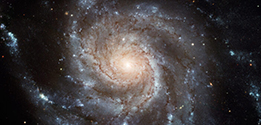It’s not every day that a supernova happens in our backyard! Earlier this year, astronomers discovered a supernova in the galaxy Messier 101, which is relatively close at just 21 million light-years away. The explosion, dubbed SN 2023ixf, is the nearest known supernova in recent years.

Discovery image (bottom left) and last image in which SN 2023ixf is not visible (top left), as seen from Koichi Itagaki’s observatory. The right-hand image shows SN 2023ixf’s location within Messier 101. [Hiramatsu et al. 2023]
A Supernova Next Door
Using a 0.35-meter telescope, amateur astronomer and prolific supernova sleuth Koichi Itagaki spotted a rapidly brightening newcomer on the outskirts of a spiral galaxy on 19 May 2023. After announcing the discovery of supernova SN 2023ixf on the Transient Name Server, the race was on. Telescopes across Earth and in space pointed toward Messier 101, also known as the Pinwheel Galaxy, to monitor the rise and fall of the newfound supernova. The behavior of the supernova’s light curve in the early days after discovery gives us critical information about the exploding star and its surroundings. What did we learn about SN 2023ixf in these early days?

Light curves for SN 2023ixf showing the evolution of the supernova’s brightness at wavelengths between infrared and ultraviolet in the first month after detection. The bottom panel shows how the color changed over time; the supernova became bluer as it brightened and redder as it faded. Click to enlarge. [Adapted from Hiramatsu et al. 2023]
In the Days After Discovery
In a recent publication, a team led by Daichi Hiramatsu (Center for Astrophysics ∣ Harvard & Smithsonian; NSF AI Institute for Artificial Intelligence and Fundamental Interactions) outlined their observations made in the month after the supernova’s discovery. Analyzing light curves and spectra from multiple telescopes, Hiramatsu’s team found that the supernova rose from obscurity to its eye-catching peak brightness in just five days before declining more gently, fading by 0.03 magnitude each day. Its spectra showed numerous bright emission lines that mark the interaction of the expanding supernova shock with gas surrounding the star.
These light curves and spectra paint a picture of a massive star collapsing as its core nuclear fusion dried up, the star’s outer layers rebounding off its condensed core in an explosion that outshone its home galaxy — a core-collapse supernova. The data also hint at something unusual: there was so much gas packed into a dense shell around the star that it delayed the escape of the shock wave that emerged from the center of the star.
The team used models to investigate the origin of this dense circumstellar material, exploring scenarios in which 1) a strong, steady stellar wind carried material away from the star before the explosion or 2) random outbursts or eruptions preceded the eventual supernova. The team found that the observations were compatible with either scenario, and in both cases, the star likely lost up to a solar mass of material in its last 1–2 years — showing that the final years of the star’s life were anything but calm.
Moving Forward by Looking Back
Astronomers will likely study SN 2023ixf for years to come. Of particular importance will be identifying and characterizing the progenitor star; ideally, we’d be able to monitor supernova progenitor stars in the years or decades before they explode to link their properties before the explosion to what happens in the aftermath. Usually, our investigations of supernova progenitor stars go in the opposite direction: we detect a supernova and then go looking through our increasingly large treasure trove of data to find the star it came from.
Already, several searches for SN 2023ixf’s progenitor star have been published. Multiple teams, using different data sets and analysis methods, have independently identified the same red supergiant as the most likely progenitor for the explosion. To clinch the candidate as the source of the supernova, we’ll have to wait to see if the fading glare of the explosion reveals that the star has disappeared. To learn more about SN 2023ixf, its possible progenitor star, and ongoing investigations of this rare nearby supernova, check out the complete list of AAS journals articles regarding SN 2023ixf here.
Citation
“From Discovery to the First Month of the Type II Supernova 2023ixf: High and Variable Mass Loss in the Final Year before Explosion,” Daichi Hiramatsu et al 2023 ApJL 955 L8. doi:10.3847/2041-8213/acf299

